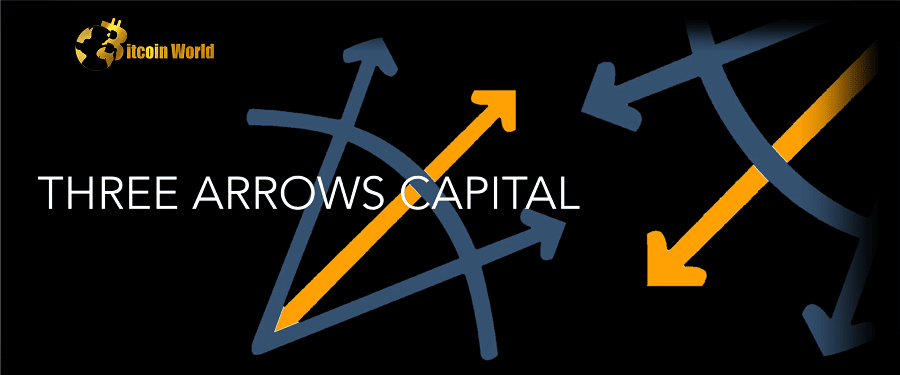The dramatic collapse of Three Arrows Capital (3AC) continues to send shockwaves through the crypto world. If you thought the FTX saga was wild, buckle up, because the 3AC story is far from over. Liquidators tasked with recovering assets for creditors are pointing fingers directly at 3AC’s founders, Kyle Davies and Su Zhu, alleging a lack of cooperation in the crucial asset recovery process. Let’s dive into the latest developments and understand what this means for creditors and the wider crypto ecosystem.
Are 3AC Founders Hindering Asset Recovery?
According to reports from BitcoinWorld, liquidators for the now-bankrupt crypto hedge fund, Three Arrows Capital, are facing significant roadblocks. The core issue? Allegedly, Davies and Zhu are not playing ball when it comes to helping recover assets to repay creditors. This accusation was brought to light by Adam Goldberg, the attorney representing the liquidators, during a recent bankruptcy court hearing.
Goldberg didn’t mince words, suggesting that the 3AC founders seem more concerned about damage control to their public image than actually assisting in recovering funds for those they owe. This paints a picture of a frustrating situation for liquidators who are trying to navigate the complex aftermath of 3AC’s implosion.
FTX Blame Game: A Convenient Diversion?
Adding another layer of intrigue to this already complex situation is the emergence of accusations against FTX. Remember the spectacular fall of FTX? Well, Davies recently gave an interview where he pointed fingers at FTX and Alameda Research, claiming they were “hunting our holdings.” He suggested this action triggered both the Luna crash and ultimately contributed to 3AC’s downfall.
However, Goldberg, representing the liquidators, finds the timing of this accusation rather suspicious. He stated:
“It’s intriguing, to say the least, that this theory that FTX was responsible for this debtor’s failure surfaced only after FTX itself experienced a spectacular collapse.”
This raises questions about whether the FTX blame is a genuine explanation or a convenient scapegoat to deflect responsibility from 3AC’s own actions and management.
Locked Offices and Missing Hard Drives: A Crypto Heist?
The plot thickens further with a rather dramatic twist. Goldberg revealed in court that before liquidators could access 3AC’s locked offices, a break-in occurred, and hard drives were stolen! This sounds like something straight out of a crypto thriller. Who broke in, and what information was on those hard drives? The circumstances surrounding this alleged theft are certainly raising eyebrows and adding to the mystery surrounding 3AC’s collapse.
The Superyacht ‘Much Wow’: A Symbol of Excess?
Perhaps one of the most talked-about aspects of the 3AC saga is the infamous superyacht, aptly named ‘Much Wow.’ Investigators discovered that funds from 3AC were used to purchase this luxury vessel. Yes, you read that right. While creditors are waiting to recoup their losses, it turns out millions were spent on a yacht.
Liquidators are now actively pursuing the recovery of the estimated $30 million spent on ‘Much Wow.’ This pursuit of the yacht highlights the lengths to which liquidators are going to recover assets, even those seemingly extravagant purchases made by the founders.
Asset Recovery: Glimmers of Hope Amidst Challenges
Despite the challenges and alleged obstruction, it’s not all doom and gloom. Liquidator Russell Crumpler testified in court that they have managed to recover some assets, totaling approximately $35 million in USD and various cryptocurrencies. While this is a fraction of what is likely owed to creditors, it does represent progress in a difficult situation.
Here’s a breakdown of what has been recovered so far:
- $35 million in USD and crypto tokens: This provides a starting point for repayment to creditors.
- Control over accounts with 60+ crypto tokens: Gaining control over these accounts is crucial for identifying and recovering further assets.
Recovery efforts are still ongoing, and liquidators are clearly determined to pursue all avenues to maximize returns for creditors. The fact that they have located the founders in the UAE and Indonesia, as revealed in court documents, suggests they are actively tracking and pursuing all leads.
Key Takeaways from the 3AC Asset Recovery Saga:
- Founder Cooperation is Crucial: The 3AC case highlights how vital the cooperation of founders is in bankruptcy proceedings, especially in complex situations like crypto hedge fund collapses.
- Transparency and Accountability: The allegations of missing hard drives and the ‘Much Wow’ yacht underscore the need for greater transparency and accountability in the crypto industry.
- Asset Recovery is a Marathon, Not a Sprint: Recovering assets in complex bankruptcies is a lengthy and challenging process. The 3AC case is a prime example of this.
- Regulatory Scrutiny Likely to Increase: Cases like 3AC will likely lead to increased regulatory scrutiny of crypto hedge funds and greater pressure for investor protection.
What’s Next for 3AC and its Creditors?
The 3AC saga is far from over. The legal battles will likely continue as liquidators pursue asset recovery, including the yacht and potentially other assets. Creditors will be closely watching these developments, hoping for further recoveries. The case serves as a stark reminder of the risks associated with the crypto market and the importance of due diligence and robust risk management. As the crypto landscape evolves, the lessons learned from 3AC will be crucial for investors, regulators, and the industry as a whole.
Disclaimer: The information provided is not trading advice, Bitcoinworld.co.in holds no liability for any investments made based on the information provided on this page. We strongly recommend independent research and/or consultation with a qualified professional before making any investment decisions.


